Aby Warburg. Mnemosyne Bilderatlas. Exposition at ZKM Karlsruhe 2016
A conversation with the curator, Roberto Ohrt
Presentation and Interview by Bianca Fasiolo
abstract
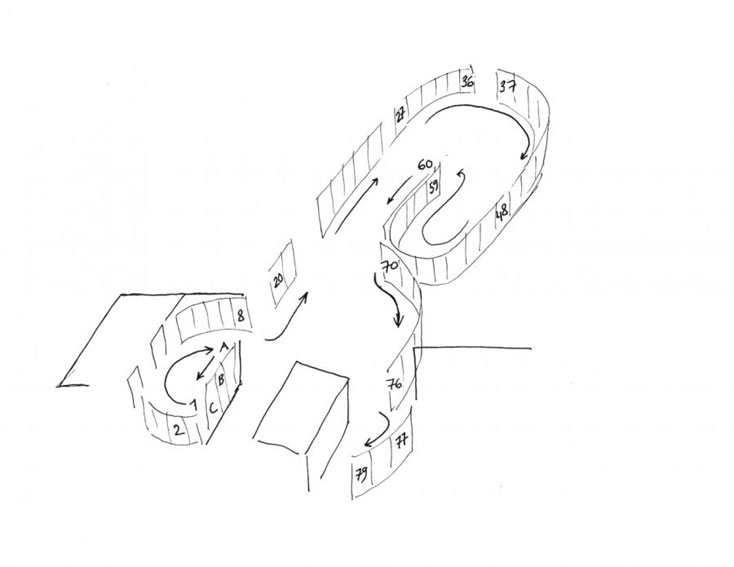
Scheme of panel arrangement prepared by 8. Salon for the exhibition at ZKM.
On the occasion of Aby Warburg’s 150th birthday, the ZKM | Center for Art and Media in Karlsruhe hosts the exhibition Aby Warburg. Mnemosyne Bilderatlas. Reconstruction – Commentary – Revision (31 August 2016–13 November 2016).
All 63 panels of the Mnemosyne Bilderatlas are here reconstructed and implemented, based on data from the Deadalus Transmediale Society, who first published the Atlas in its entirety, in 1993. The panels are presented in their original size and provided with a commentary for each plate, all available in the Magazine “Baustelle”. The exhibition presents the last version of the Atlas, which was left unfinished at the moment of Warburg’s death, in 1929. In addition, panel 32 and panel 48 have been recreated with the original images preserved in the Warburg Institute in London, where the Kulturwissenschaftlichen Bibliothek was moved from Hamburg before the Second World War. The “Revision” part is then dedicated to Contemporary Art: 12 artists and connoisseurs have been asked to produce a personal piece by shaping their studies and their practice in the form of an Atlas’ panel.
The first week of the initiative started with a complete guided tour through the panels, conducted by the members of the Mnemosyne research group at the 8. Salon Cultural Center in Hamburg. The group – which includes the curators Roberto Ohrt and Axel Heil, together with Christian Rothmaler, Giovanna Targia, Philipp Schwalb, Regine Steenbock, Jochen Lempert, Marcel Hüppauff and others – has been taking care of the reconstruction of the Atlas since 2011. In these years, individual sequences of four to six panels were analyzed for the scope of public events. In parallel, the research results were collected in the 13 editions of the Magazine “Baustelle”, now available at the ZKM. The Group’s work has already been presented in the past, in Hamburg and St. Gallen (Switzerland), and in the Villa Romana (Florence), but the Karlsruhe exhibition is the first one that decoded and commented every single panel.
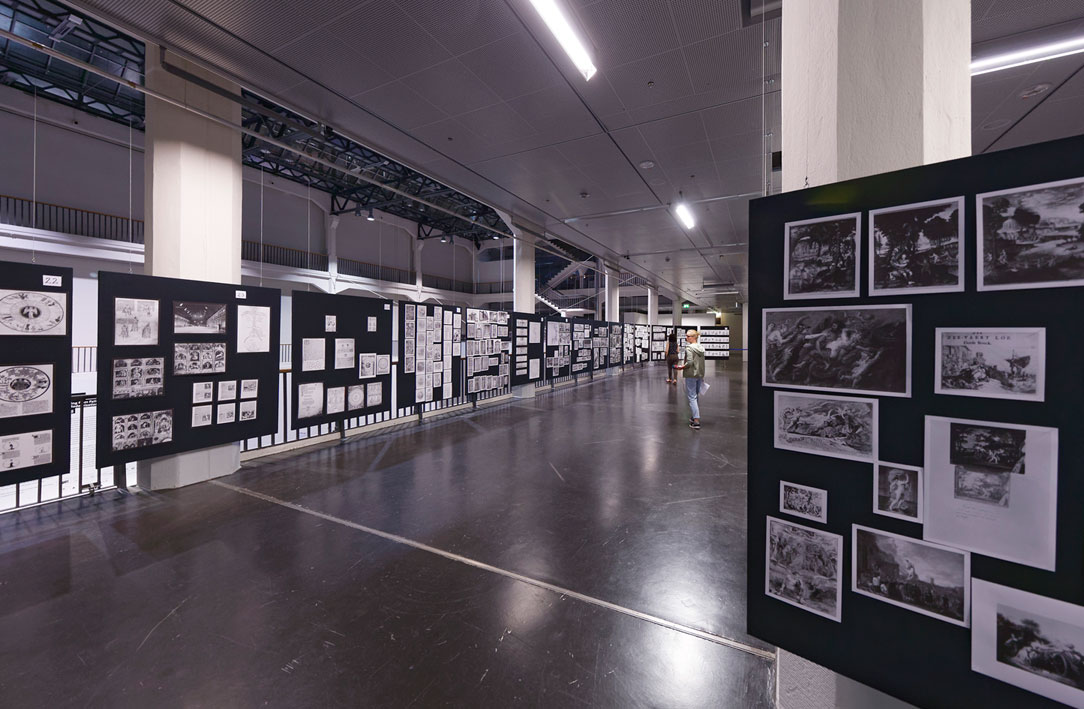
View from the installation Aby Warburg. Mnemosyne Bilderatlas. Reconstruction – Commentary – Revision, ZKM 2016.
The exhibition also presents other materials that are useful in understanding the structure of the Atlas and its influence in the present time. Regine Steenbock, from the Mnemosyne Research Group, proposes, always in the form of a panel, a contribution to the “emergence of the Burgundy Larva from its cocoon”, focusing on a well-known topic addressed by Warburg and bringing it into the contemporary age, using outfits of pop stars and famous athletes as examples. The exposition also hosts three different screenings on the figure of Warburg and his Bilderatlas: “Aby Warburg: Metamorphosis and Memory”, by Judith Wechsler, 2016; “Die Menschenrechte des Auges”, by Eva Maek-Gèrard, 1981; and “Aby Warburg, the archive of Memory”, by Eric Breitbart, 2004.
The curator Roberto Ohrt gave us a first insight into the research carried by 8. Salon, and how the entire project began.
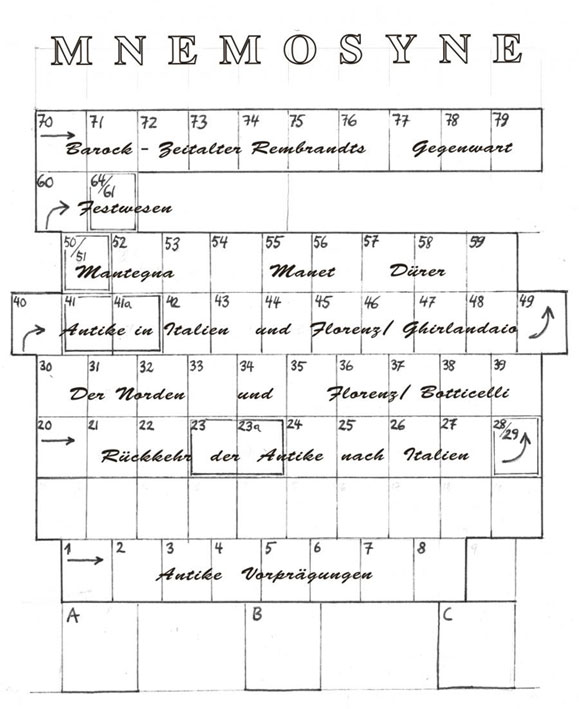
The architecture of the Atlas. The image is taken from “Baustelle” n.11. From above: The Baroque-the era of Rembrandt, present time. Festival culture. Mantegna, Manet, Dürer. Antiquity in Italy and Florence, Ghirlandaio. The North and Florence/Botticelli. Return of Antiquity to Italy. Ancient predispositions.
A conversation with the curator, Roberto Ohrt
Bianca Fasiolo | Could you introduce us the 8. Salon and the Mnemosyne research group?
Roberto Ohrt | The 8. Salon headquarters has been there for five years now. It is a mix of library, exhibition space, studios and gallery, but we now have our own program. One year after we started running the space we thought it would be interesting to see the Atlas. It was basically for our own curiosity and it then slowly turned into this long investigation.
As you know, in Hamburg, Warburg is a little bit everywhere. The Kunsthalle, the Art Academy, the Faculty of Art History, the Warburg-Haus: there is a little bit of Warburg everywhere, which is rather a good reason for not doing anything in this territory. So it was only our curiosity: why not having his Atlas and see it in the original format? No grand intentions.
I had published a compilation of texts by Edgar Wind (Heilige Furcht) before, and that is how I firstly approached the issue.
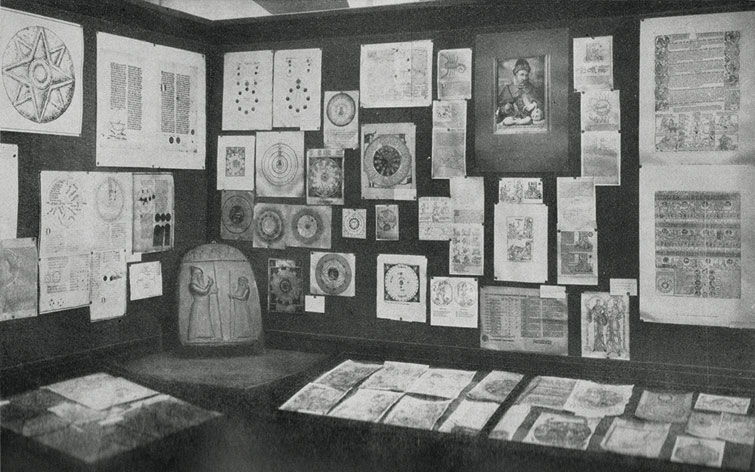
International exhibition of the Book Industry and graphic arts - Bugra, Leipzig 1914.The photo was taken in the Room of Mathematic, Physics, and Chemistry of the “Wissenschaftliche Grafik” department located in the Cultural hall of the fair [zoom].
The exhibition at ZKM opens with an introduction to the Bilderatlas. At the very entrance, it is possible to see an enlargement of the so-called Wanderkarte that entirely covers the walls of the room. The Wanderkarte is a map shown in the first panel of the Bilderatlas, panel A, and it is considered one of the tools provided by Warburg to interpret and find orientation in the reading of the Atlas itself. Next to the names of the cities, considered relevant for the migration of images in time and space, Warburg’s most important terminology has been added to the chart: “Bewegtes Beiwerk” (“moving accessories”), “Bilderfahrzeuge” (“image vehicles”), “Energetische Inversion” (“energetic inversion”) and others, all provided with a short explanation. The first room has, in fact, plenty of suggestions on how to approach the Atlas and on what could have been the inspiration for the author in structuring his masterpiece. Another compelling lead that has been proposed is a photograph of the International Exhibition of the Book Industry and Graphic Arts in Leipzig, 1914. The image, a discovery of Marcus Andrew Hurtting, shows a possible precursor for the shape of the Mnemosyne Atlas: an exhibition room completely full of different-sized reproductions of drawings, paintings and manuscripts carefully distributed along the space. A display strategy that was apparently quite common at that time.
Roberto, what could you tell us about the possible sources on the exhibition that inspired Warburg for the construction of the Bilderatlas?
I don’t think this Atlas came out of the blue, I don’t think that it is something that he invented completely. If somebody invented it, it was Saxl, but I don’t think he invented it either. I think it was just a byproduct of the development of the media in the early 20th century, which you can see in magazines, newspaper, and looming journals.
This exhibition in Leipzig is especially interesting because it is, at least partially, really close to what Warburg did: the importance of books, the importance of illustrations, the effect of illustrations on the development of art products – these are all topics closely related to his activity. And – a funny and unknown detail in this story – the exhibition was organized by people from the institute of Karl Lamprecht, who was closely connected to Warburg and influenced him very much. I did look for the catalogue of the Leipzig show in the Warburg Library in London, but they surprisingly don’t have it. I believe it simply got lost.
The Bilderatlas isn’t very far away from what is shown in that picture, and we may say now that Warburg didn’t invent something new, even though this doesn’t change much: his use of such a medium is new and very special. There is a big difference between what Saxl and Gombrich did, and what Warburg was able to do. He was playing with a big orchestra, while the others were applying a canon. This shows his knowledge: to use an instrument that big, to work with it. That is actually what we did find out. When you start to look closely at each panel, you learn the language and then enter inside it.
On the one hand, the Leipzig example shows that the Atlas is something that is recurring in these years, as a product of the development of technology. But at the same time, it is something special when you look at Warburg’s case. Now, why do we talk about the structure and the “architecture” of the Atlas?
First, let’s say that architecture in the late 19th Century is maybe the most important official “medium” of art. If you go to cities like Vienna or Paris you can still perceive this.
So if we talk about the “architecture” of the Atlas, first we need to remember the meaning of architecture in Warburg’s cultural background. Then there is this concrete building, the Library, finished in 1926, where the Atlas takes shape. Warburg creates the Bilderatlas at the centre of this building, in this house full of books and people reading, developing their knowledge. The Atlas is his contribution to the “Laboratorium”, as he called the Library, a motor of producing knowledge in that space, in the same hall where it was constructed and exhibited. This is, in fact, another dimension of the metaphor on architecture.
From 1926 to 1928, the Atlas was developed more on a horizontal structure: the panorama in the oval hall for the lectures. Then, from ’28 and ’29, the vertical orientation slowly took over, because it was meant to become a book, and they begin to think in terms of pages. It isn’t so much a panorama anymore, but each page stands for itself. However, there are sequences that are made from eight to ten panels, which are equivalent to a full panorama of one set of panels in the Library hall. In this way, I think, he considers everything in one big view, in which he can show the whole development of all Rembrandt, for instance. That makes the building become a condition for the dimension of the Atlas: the structure in ten-panel-sections comes from the hall’s space. Even if you see holes in the panel numeration − Warburg always restarts from 20, then from 60, then 70 − you can tell that he is thinking by tens, even if not too strictly. I would not consider this as a dogmatic rule, but it is obvious. And then, there is also the volume of one single view, with correspondences from left to right, that you can see as a whole. The inner logic of the Atlas comes from here, I think, and one can see Warburg experiencing the development of his work in the lecture hall. I am not saying you can see the structure of the building in the Atlas directly, but I’m only talking about the dimension of the experience, what you can see in one view.
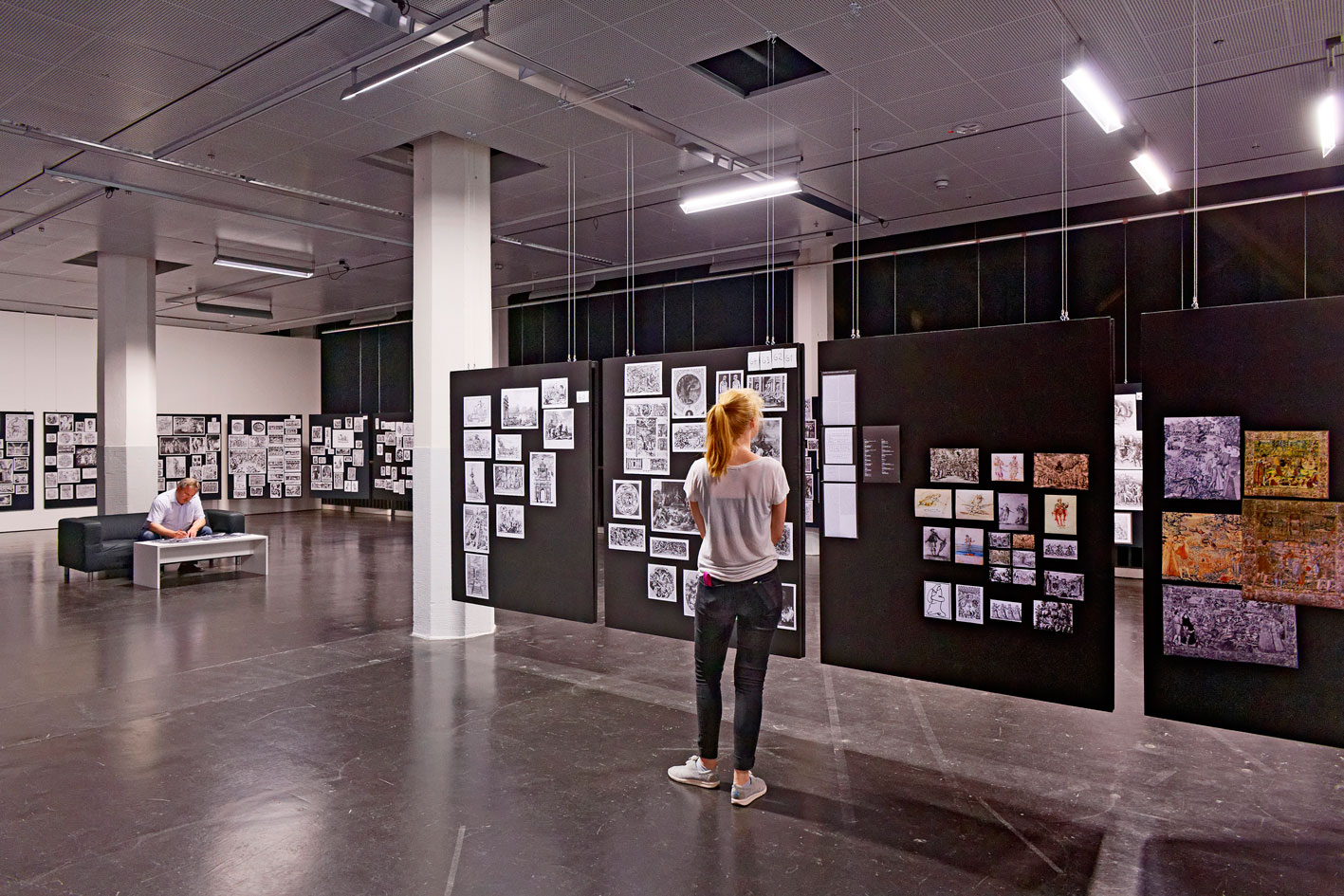
View from the installation Aby Warburg. Mnemosyne Bilderatlas. Reconstruction – Commentary – Revision. ZKM 2016. On the right side, it is possible to see the reconstruction of panel 63 and 64.
Talking about the progressive numeration of the panels, many of them are still missing. I have found your attempt to propose a reconstruction of plate 63 and 64 interesting. Would you like to talk about the research process that brought you to the results shown in the exhibition?
From 61 to 64 is one panel, and if you observe it closely it seems like it is complete, finished. So, what is the meaning of the numbers? For the themes of Neptune and festivities, you can see that more panels are necessary. This is what we thought. When you then compare the final version of the Atlas with the versions that had been documented before, you find that these two panels – which we propose to put there – were constructed and ready but they were not integrated with the last version. They perfectly fit the dimensions and the theme of the other panel in the same row, therefore we tried to edit them. We can argue, in fact, that after he presented the second version, a third one was only a matter of time... but he died in the meantime. I mean, the thing became bigger and bigger! The second version of the Atlas was bigger than the first one, but when you look at the third version it is even bigger since it is more detailed in the parts that were completed. Other parts were not yet done at that time.
Another thing is the ‘hole’ from 9 to 19. With one little exception: a completely unfinished unnumbered panel, documented in the Archive. There is nothing we can put there. I think it comes from the idea of developing the final version, following a chronological order. The second version, for instance, is certainly also a historical – and in that sense: chronological – work, but pictures and objects from Antiquity and early Renaissance are completely mixed. In the last version, they are separated, and the chronological order becomes more and more apparent. There was a discussion between Saxl and Warburg, and Saxl was completely against this new chronological system. So, there is no question that this decision was made, but what were the consequences? I think we can see what Warburg was expecting from Saxl: he should have presented the survival of Antiquity in Medieval times on the panels from 9 to 19.
Warburg had taken over the Library when he came back from Kreuzlingen and Saxl was pushed aside. So in the following years he was always travelling – England, Spain and so on – avoiding the situation of the Library to a certain degree, and consequently he was not very much involved in developing the Atlas. Secondly, Saxl had a completely different approach to illustrations – and to Warburg’s Atlas. This is obvious when you see the book he published in 1931 on Mithras (Typengeschichtliche Untersuchung) – by the way a perfect example for the printing quality Warburg wanted for the Atlas. It shows that Saxl had no “use” of the Atlas as an instrument, and that he couldn’t deal with the complex structure of each panel. He certainly delivered useful material, bringing examples of images, but I doubt that he could construct a panel in a Warburg’s way, and this is why we are missing this part.
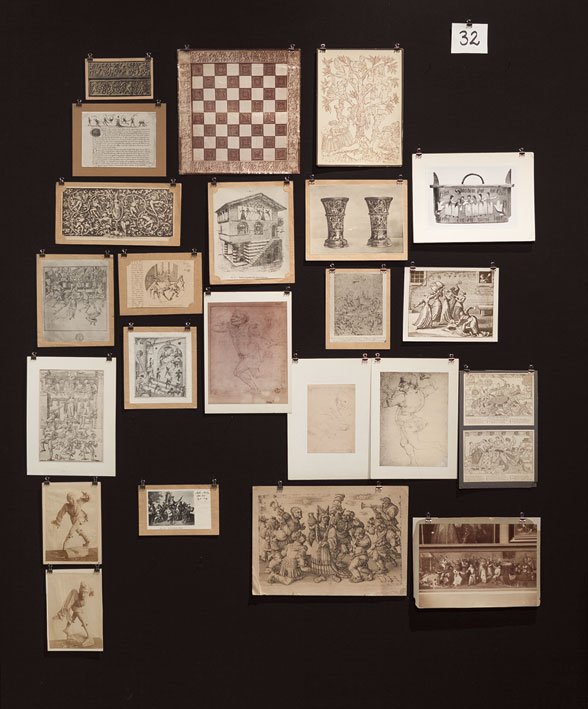
Reconstructions of panel 32. The original images are taken from the Photographic Collection of the Warburg Institute, London [zoom].
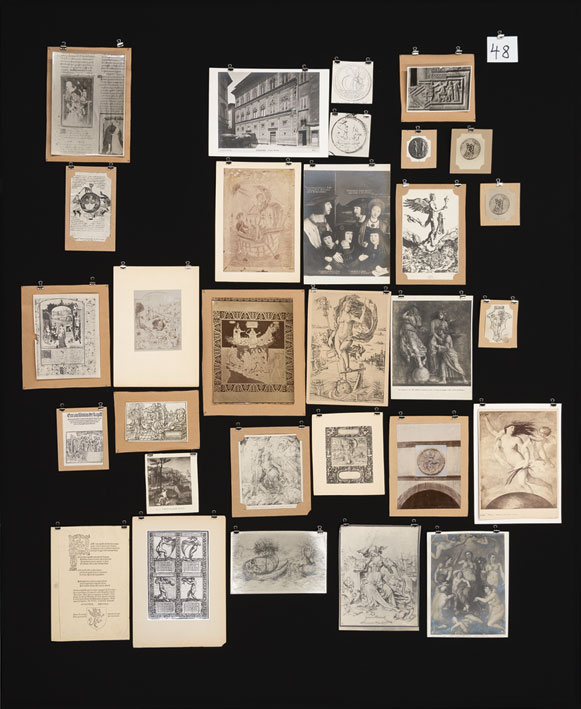
Reconstructions of panel 48. The original images are taken from the Photographic Collection of the Warburg Institute, London [zoom].
In the exhibition, the reconstructed panels of the Atlas are the exact same size of the originals. In addition, the dimensions of each image were deduced thanks to the photos provided by the Wien-based Deadalus Group. What is interesting in your research is the attempt to reconstruct two of the panels with the original materials coming directly from the Photographic collection of the Warburg Institute in London. Your proposals for number 32 and 48 differ quite a lot from the other panels since it is still possible to recognize the original sources which they were taken from. In your opinion, to what extent does the fruition of the Atlas change from its original version to the photographic one we are now used to?
Certainly, 32 and 48 look really different from our reconstruction of the Atlas. We always thought that the original panels made by Warburg had all these different materials. You can see it from the documentation: photos from Alinari, photos he might have taken himself, illustrations from books, etc. The diversity of the materials on the panels was, therefore, clear. On the other hand, we didn’t want to use too much imagination in reconstructing what Warburg did exactly. “What is this grey, this blueish, this brownish? Whatever...”. Actually, he himself meant to turn it all into one album or a book and consequently into one color. Then, you have to avoid fetishism: it is not about seeing exactly or touching what Warburg held in his hands. The reconstruction with the originals from the Photographic Collection, however, was a challenge. Deadalus tried to go this way, but since then nobody did it again. In fact, what you see now when you look at the original version is that Warburg was confronted with a “zoo of flies” or with a complicated Zettelkasten – to use a German word. And Zettelkasten was what he always was dealing with: boxes full of little notes. In German we have this other word Zettelwirtschaft, note-economy, which means that someone is on the verge of losing control by keeping everything on little bits of papers, a state of something that is really undeveloped. So that’s what Warburg had in front of him – and that’s what later people, like Gombrich, said about him and his Atlas: a never-ending story of a man unable to keep things straight and bring them to an end. It is really much easier to understand things when you don’t have all the different rough materials: with our reconstruction we are much closer to an appearance of unity. On the contrary, the original is something that tends to slip away any moment... like kids on a playground. So – in opposition to Gombrich – I think that his ability to keep it all together is here even more visible.
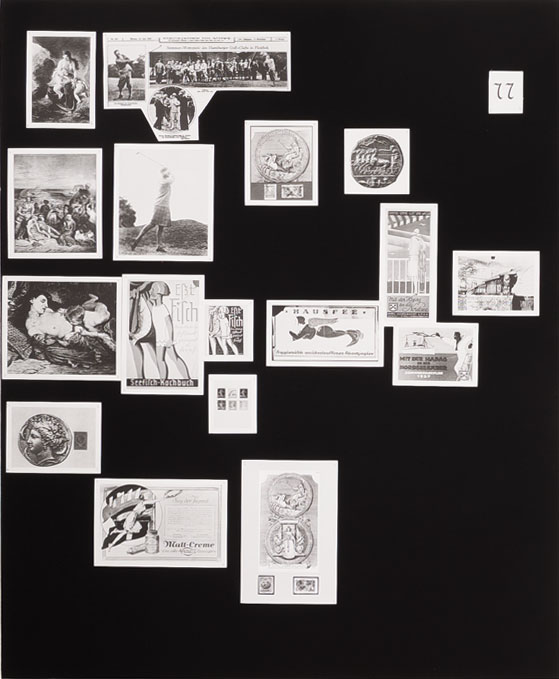
Reconstruction of panel 77 with the reproductions based on the data of the Deadalus Transmediale Society [zoom].
Talking about reconstruction, you did another attempt with panel 77, placing real objects instead of reproductions: coins, flyers, and one video as well. Isn’t that so?
Number 77 is an exception in the Atlas because if you see the photos we have of it, it has no margins and so we don’t know how big it really was. All the other photos have margins where you can see the bookshelves in the background. This is not the case with panel 77. I think, and it is visible from the photo, that here he used the original materials, like advertisement sheets for instance. Here it is even more striking to see how he focused on his everyday life surroundings at that time.
The whole panel is – in terms of order – a real disaster since it is really sketchy, but this is also an advantage because you can notice how he was building it. As one can see, two lines on the left side are traced all the way to the end. The other side, instead, is all about tracing a line here, drawing a cross there, etc. He is constructing the problem and reflecting on how to display it. At the same time, he is using materials he just found two weeks before. For example, he often spent some days on the Island of Helgoland, few hours by ship from Hamburg, and took the ferry schedules and a postcard of a monument that was inaugurated in September 1929, and placed both of them there!
Concerning the video that we put on the upper right part, it was an important movie for the construction of panel 78. It was produced by the fascist right after the Lateran Pacts ceremony, which took place in February 1929, as a sort of silent newsreel clip. Warburg saw it in the movie hall, and you can trace the effect in the organization of the panel. There are obvious similarities between the newsreel and panel 78, to the point that you find the same exact photo of the Pope in the movie and on the panel. The funny thing is – and you don’t notice it until you look at the image in the panel – that it is just a picture in the film too.
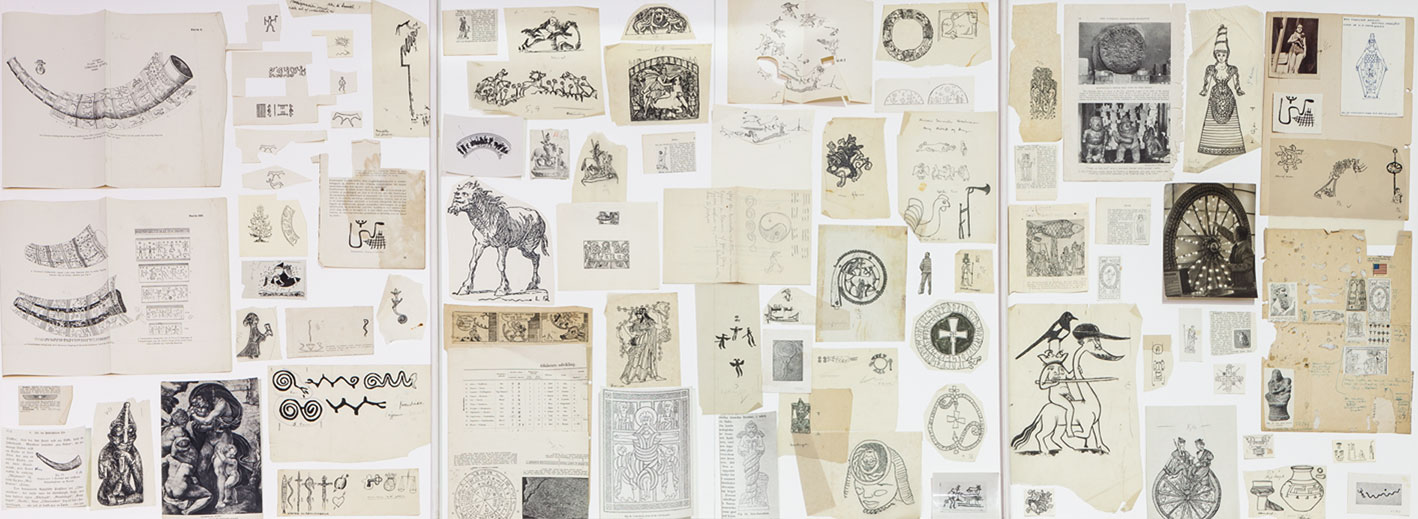
Materials collected by Asger Jorn for his book Guldhorn og Iykkehjul, the Golden Horns of Gallehus, published in 1957. Part of the collection is centered on the golden horns and the wheel of fortune [zoom].
The exhibition hosts the participation of contemporary artists as well. On the one side, the figure of the Danish painter Asger Jorn (1914-1973) is introduced together with the panels of the Atlas, near the original reconstruction of number 48. A small part of his collection of pictures – recurring symbols, schemata and rituals –has been displayed to underline the resemblance with Warburg’s work. The main interest of Jorn was to keep track of how the classical Greek canon met Northern Europe, transforming forms and meanings of gods and heroes belonging to the Scandinavian culture. The similarities with the Bilderatlas are therefore not only on the level of structure and editing but also on that of the idea of “Wanderstrasse der Kultur”. Images of astrological planets, the Mithra group motifs and the wheel of fortune are images that the artist followed carefully in his research, and that can be found in the Atlas as well. On the other side, the last part of the exposition presents 12 panels created by 12 contemporary artists. This is an initiative carried out by 8. Salon from 2014 and that is now a permanent part of the Atlas’ presentation program. The instructions given to the artists were to maintain the panels’ format and colour and develop the work in their personal artistic language.
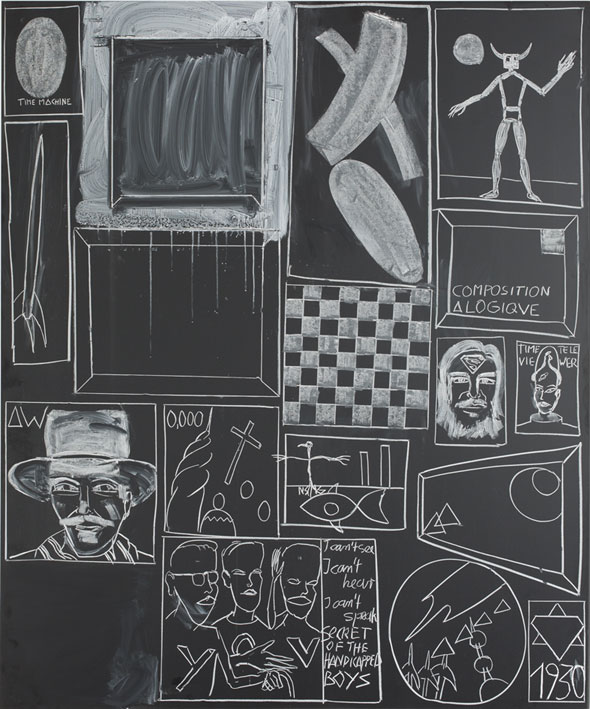
Could you tell me something about this idea of 8. Salon to exhibit contemporary artworks? I would like to have your opinion on why and how the Atlas tends to attract so many artists, maybe more than art historians and connoisseurs.
One year after starting the whole thing, we began to ask these artists to participate in the project. Bizarrely enough, artists react more quickly and positively to the Atlas. Any time you show a panel to an artist you get a bigger response, it is just more productive. Our research group is more or less composed of artists. This is one of the reasons why we had the idea to simply make clear that this was a problem. And what do you do with the problem? You increase it. We decided to ask the artists to produce something similar. To just do exactly what an art historian would never dare to do.
Then, we don’t need to discuss the question of the Atlas being a piece of art or not. It is the wrong question to me and it doesn’t go anywhere. Warburg was a scholar, an academic, a researcher, organizer of discussions, and at the same time, he offers sompyhing that is very distant from a scientific text. He, rather, has a closer connection to thinking through pictures. He obviously finds, in this, something more productive for him than to write a text. We don’t need to decide if this is an artistic attitude or not. I just say that he presents something that is closer to being an artist.
There are several reasons behind involving these different artists in the project. Albert Oehlen for example, in his painting, integrates advertising, and compares different images. That gave us the idea to involve him, and the same was for the Danish painter Tal R, who did a whole exhibition with his collection of images. We simply try to enter this area where artists do something similar to Warburg’s work, or act in a territory, which is also close to what Warburg did. And we leave the rest to them.
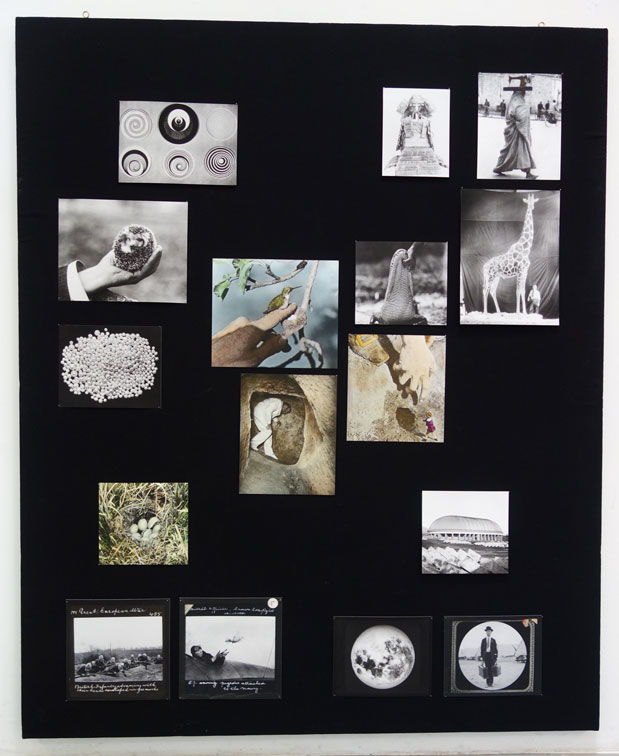
The works by Andy Hope 1930 and Linda Fregni Nagler on display (both 2016).
Another important aspect that helps to locate Warburg in our present time is the important role he plays in the development of what you call pictorial science or the science of picture. Could you explain to us what do you mean by that?
There is still a lot of speculation about the whole pictorial science thing, about the meaning of this “power of images”. What exactly is this power then? When you see something like the Atlas, where there are a lot of images and you have to find and think about the connections, you could come to the same conclusions of Panofsky concerning its function. But with Panofsky I have often the feeling that he wants to “close the case”. On the contrary, with Warburg you have the impression that he wants to open up questions. Maybe it is just a coincidence that he didn’t write any comment, that we now have to think about the panels without the accompanying text and focus more on the language of the pictures in itself. In fact, even without the written part, the Atlas doesn’t lose its force or its dimension.
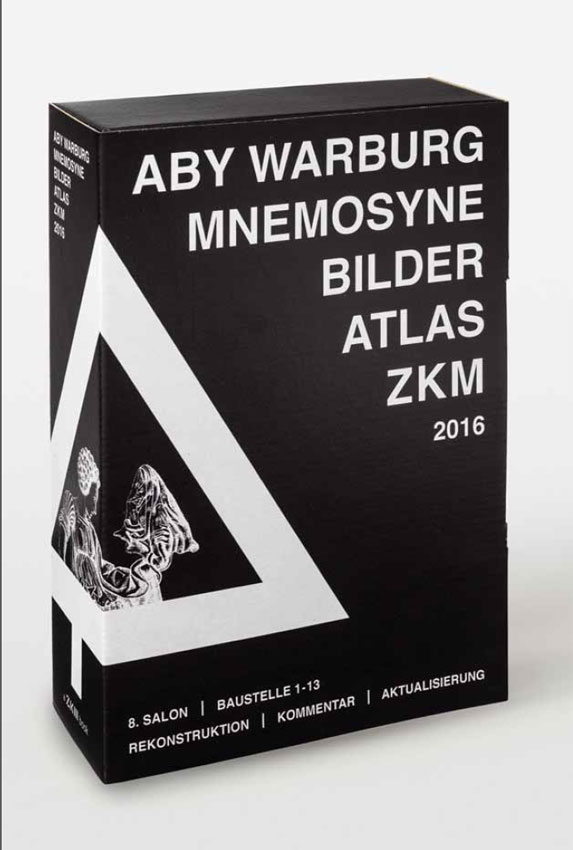
The Box, containing “Baustelle” 1-13, published with ZKM for the show.
Warburg was someone who worked with this science of pictures and certainly was not interested in establishing a better Art History. That is also a difference. As he always said, with these images he was integrating all different areas of science and, maybe, the image could be link the precise link. Astrology, History of Technology, Art History, Cultural History... the connecting element is, for him, the image, and we can see that in the Atlas. Some panels focus more on this than others, like number 52 where we find a compilation of the most different techniques of image production. Bad images, uninteresting ones, profane, high end, sketches, woven and printed... it seems that he really wants to have as many different techniques of producing images as possible.
This is just one thing he is pushing with the Atlas, although it is definitely his aim, and it is completely beside the art historian’s orientation of his time. Let’s take panel 48, the Fortuna panel (see, in “La Rivista di Engramma”, Bilderatlas panel 48 and its content analysis; see as well in “Baustelle” 8.4 (2016) extended commentary on panel 48). In the end, there is no major artwork in the focus. What interests him, is only Fortuna itself. He is not saying, let’s praise this famous painting – let’s say – of Bronzino, which is actually in the right corner of the last piece on the panel, maybe the only masterpiece in it. Almost none of the other pictures are artwork, pieces that “stand for themselves”, something you would talk about. I find it funny!
NB: Special thanks to Barbara Kiolbassa, ZKM Museum Communication.
Abstract
An interview with Robert Ohrt, the curator of the latest exhibition - very important for the warburgian studies - Aby Warburg. Mnemosyne Bilderatlas. Reconstruction – Commentary – Revision (31 August 2016–13 November 2016) hosted at the ZKM | Center for Art and Media in Karlsruhe.
keywords | Warburg Atlas; Roberto Ohrt
Per citare questo articolo / To cite this article: B. Fasiolo (a cura di), Aby Warburg. Mnemosyne Bilderatlas. Exposition at ZKM Karlsruhe 2016. A conversation with the curator, Roberto Ohrt, “La Rivista di Engramma” n. 139, novembre 2016, pp. 117-131 | PDF of the article